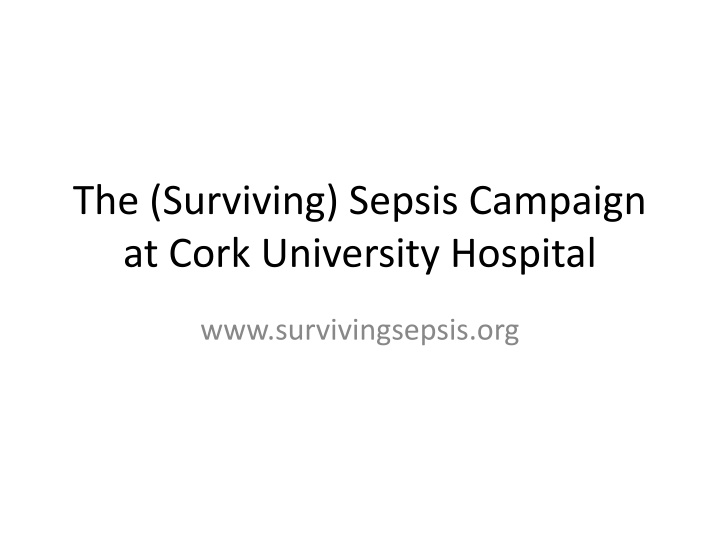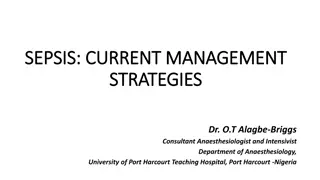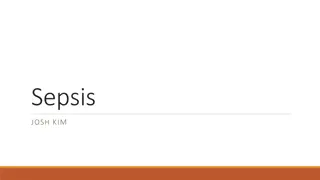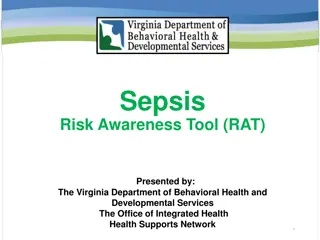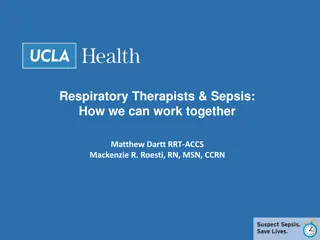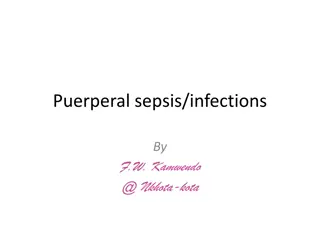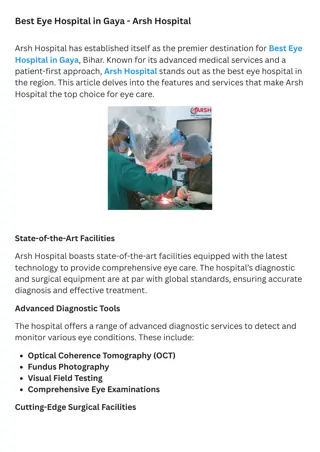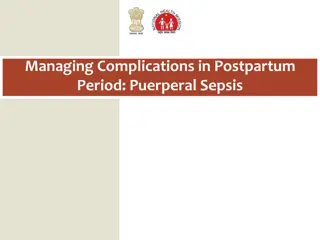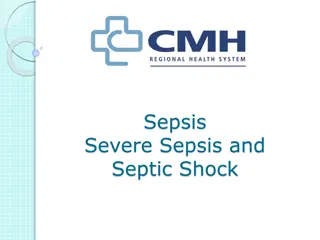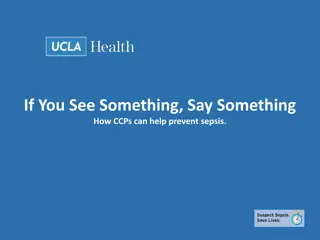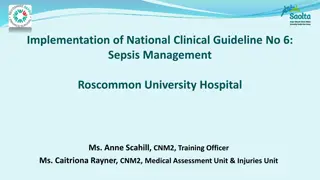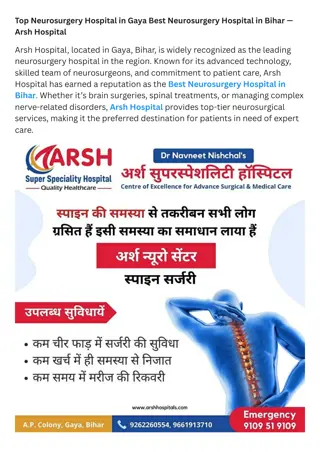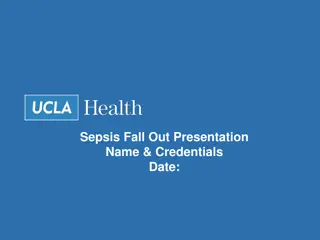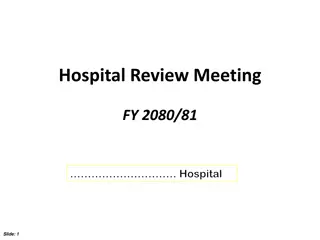Surviving Sepsis Campaign at Cork University Hospital
The Surviving Sepsis Campaign at Cork University Hospital aims to reduce mortality from Severe Sepsis worldwide through a joint collaborative effort of the Society of Critical Care Medicine and the European Society of Intensive Care Medicine. Participating hospitals gain access to educational programs, quality improvement experts, and benchmarking opportunities. The Campaign has evolved through phases focused on reducing sepsis mortality, developing evidence-based guidelines, and facilitating guideline adoption through partnerships with organizations such as the Institute for Healthcare Improvement.
Download Presentation

Please find below an Image/Link to download the presentation.
The content on the website is provided AS IS for your information and personal use only. It may not be sold, licensed, or shared on other websites without obtaining consent from the author.If you encounter any issues during the download, it is possible that the publisher has removed the file from their server.
You are allowed to download the files provided on this website for personal or commercial use, subject to the condition that they are used lawfully. All files are the property of their respective owners.
The content on the website is provided AS IS for your information and personal use only. It may not be sold, licensed, or shared on other websites without obtaining consent from the author.
E N D
Presentation Transcript
The (Surviving) Sepsis Campaign at Cork University Hospital www.survivingsepsis.org
The Surviving Sepsis Campaign SSC Joint collaborative of the Society of Critical Care Medicine and European Society of Intensive Care Medicine Its aim is to reduce mortality from Severe Sepsis worldwide
Sponsoring Organizations American Association of Critical-care Nurses American College of Chest Physicians American College of Emergency Physicians American Thoracic Society Australian and New Zealand Intensive Care Society European Society of Clinical Microbiology and Infectious Diseases European Society of Intensive Care Medicine European Respiratory Society Infectious Disease Society of America International Sepsis Forum Society of Critical Care Medicine Surgical Infection Society Canadian Critical Care Society Japanese Society of Critical Care Medicine Japanese Association of Acute Medicine German Sepsis Society Latin American Sepsis Institute
Why Participate in the SSC? Participating hospitals have: Access to free educational programs by world- renowned sepsis experts Access to experienced, trained quality improvement experts Access to colleagues at other institutions who share the commitment to improving care for patients with sepsis Benchmarking: Access to the SSC database to enter your data and get reports on your performance
Surviving Sepsis Campaign Phase 1: Barcelona Declaration (2002): Reduce mortality from severe sepsis and septic shock by 25% Phase 2: Development of Evidence-based Guidelines (2004) Second edition published 2008 Third edition released January 2013 Revised April 2015 Phase 3: Education and Implementation Development of Sepsis Bundles
Surviving Sepsis Campaign Phase 3 Partner with Institute for Healthcare Improvement (IHI) Facilitate adoption of guidelines Benchmark performance
The SSC Guidelines Initial Bundle Measure lactate level Obtain blood cultures prior to administration of antibiotics Administer broad spectrum antibiotics 4 Administer 30ml/kg crystalloid for hypotension or lactate 4mmol/L
The SSC Guidelines 6 hour Bundle In the event of persistent hypotension after initial fluid administration (MAP < 65 mm Hg) or if initial lactate was 4 mmol/L, re-assess volume status and tissue perfusion and document findings Apply vasopressors (for hypotension that does not respond to initial fluid resuscitation) to maintain a mean arterial pressure (MAP) 65mmHg 6. Re-measure lactate if initial lactate elevated.
The SCC Guidelines Reassessment of fluid status EITHER Repeat focused exam (after initial fluid resuscitation) by licensed independent practitioner including vital signs, cardiopulmonary, capillary refill, pulse, and skin findings. OR TWO OF THE FOLLOWING: CVP ScvO2 Bedside cardiovascular ultrasound Dynamic assessment of fluid responsiveness with passive leg raise or fluid challenge
Surviving Sepsis Campaign Phase 3: Results 252 sites in 18 countries 15,775 subjects Sites entered patients from 1 to 37 months Levy MM et al. CCM 38(2):367-374, February 2010.
Change in Compliance Over Time Levy MM et al. CCM 38(2):367-374, February 2010.
Change in Mortality Over Time Levy MM et al. CCM 38(2):367-374, February 2010.
Longer Term Results Hospitals with 3 and 4 year participation in the SSC showed continued improvement over the entire period of participation No plateau seen in benefit Compliance with bundles continued to increase Hospital mortality continued to decrease Data in publication
SSC: The Next Phase Increase the number of hospitals contributing data to the Surviving Sepsis Campaign to 10,000 worldwide Apply the guidelines to 100% of patients in whom the diagnosis is suspected Develop a strategy to improve the care of septic patients where healthcare resources are limited
SSC: The Next Phase Assuming that the reduction in mortality seen to date can be sustained and 10,000 hospitals comply with the Campaign recommendations, 400,000 lives could be saved if even only half of the eligible patients were treated with the Surviving Sepsis Campaign Bundles
Surviving Sepsis Implementation Cork University Hospital
Surviving Sepsis- the IHI model Learn about quality improvement in sepsis Establish a baseline- start by collecting data before formal improvements e.g. collect data on sepsis patients in the ICU Ask for administrative buy in and form a team Develop an institution specific protocol that includes the bundles/screening tool to identify patients Educate staff on the floor Recount success and remediate errors through monthly feedback from the SSC database
Forming the Team Aim: Start with ED to implement best possible care for septic patients, using the known evidence with a view to rolling out to the rest of the hospital Core Leadership Team: The Deteriorating Patient Governance Group The leadership team is interdisciplinary reports to the Hospital Quality and Safety Committee Executuve Management Board Critical care medicine physician ED physician Clinical Educator Risk Manager ED nurse facilitator ED nurse manager ED charge/triage nurse Sepsis Lead Nurse Others .NCHDs
Role of Collaboration ICU ED 19
Sepsis- 10 point plan 1. The team multidisciplinary ED/ICU nursing and medical/enthusiasts/front line workers 2. Develop a screening tool and management bundle protocol based on guidelines- distribute to all even the naysayers 3. Education sessions- interdisciplinary where possible. On the floor, grand rounds, undergraduate, launch 4. Collect the data- start small- Patients admitted with severe sepsis from the ED to ICU. Set an achievable goal
Sepsis 10 point plan 5. Notify administration of the project 6. Collaboration -team meetings focused on change (keep it short!), use results of data to drive change (PDSA). Keep it small at first 7. Notify all stakeholders of even small success 8. Bring results and successes to administration to gain further support 9. Build the improvement process stepwise to other bundle components of sepsis care 10 The hospital floor ..
Initial Bundle Compliance 100 90 80 70 Percent in Compliance 60 50 40 30 20 10 0 Nov-14 Dec-14 Jan-15 Feb-15 Mar-15 Apr-15 May-15 Jun-15 Jul-15 Aug-15 Sep-15 Serum lactate within 3 Hrs Blood Culture before Antibiotics Antibiotic Compliance Fluids for hypotension or elevated lactate
Six Hour Bundle 100 90 80 70 Percent in Compliance 60 50 40 30 20 10 0 Nov-14 Dec-14 Jan-15 Feb-15 Mar-15 Apr-15 May-15 Jun-15 Jul-15 Aug-15 Sep-15 Vasopressors for hypotension CVP measured within 6 hrs ScvO2/SvO2 measured within 6 hrs Lactate remeasured within 6 hrs
Challenges. Other areas of the hospital Feedback on a case by case basis NCHD engagement Ongoing education Signing of sepsis screening forms Resources The honeymoon problem
Positives Visible successes Wider patient care issues out in the open Engagement with hospital management The level of commitment from staff to improve patient care THANK YOU
